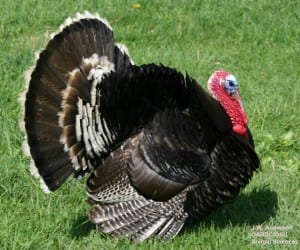By Diane Wright Hirsch, MPH, RD
UConn Extension Educator – Food Safety

The origins of the American Thanksgiving celebration can be debated. For early settlers, the occasion was often religious in nature, offering thanksgiving and praise for many blessings, not just a bountiful harvest. But, traditionally, we are taught that the Pilgrims celebrated the first Thanksgiving Day in 1621, following their first harvest in the New World. Accounts indicate that this was a three day feast, attended by both the new world settlers and Native Americans, who shared what they had produced as well.
In 1863, Thanksgiving was given national holiday status in a proclamation by Abraham Lincoln, to be celebrated on the final Thursday in November. While it has come to mean many things (football, the beginning of the holiday shopping season, etc.), the holiday continues to be a celebration that is centered on bringing family and friends together for a large meal, often at least partially based on that 1621 Pilgrim feast.
One thing we know for sure…the meal shared by the Pilgrims and the Native Americans was locally grown! It might have included turkey, but definitely duck, goose, or even pigeon and venison; shellfish, including lobster, oysters, mussels and clams, smoked fish; corn porridge made from Indian corn; chestnuts and walnuts; and pumpkins and squashes. Potatoes and cranberries had not arrived yet: and if they had pumpkin, there was no pie, as flour was not available. They might have had some fresh vegetables, but in November they were likely limited to onions, beans, cabbage, and carrots.
Chances are, they meal was composed to a large extent of meat, fish, and fowl and more meat, fish and fowl.
So, since we, too, are located in proximity to the first northeastern settlers, why not be true to tradition (at least a little bit!), and try for a Thanksgiving feast composed of food grown and/or processed in Connecticut. It can be done pretty easily with just a little effort.
First, consider what produce is seasonally available. The Crop Availability Calendar located on the Connecticut Department of Agriculture (DoAg) web site (go to www.ct.gov/doag and click on “Where to find Connecticut Grown Products”), indicates that in November, apples, carrots, greens, mushrooms, onions, pears, potatoes, turnips and winter squashes (including pumpkin, acorn, butternut, and others) are available. Find these fruits and veggies at a farmer’s market or local farm stand near you. Occasionally you may be able to find local products at your larger grocery store as well, but support your farmer at the source. There are over a hundred farm stores in Connecticut. A listing by county can be found on the DoAg website as well. Farmer’s markets are beginning to wind down for the season, but many remain open until Thanksgiving, selling the very produce listed above. At least 10 on the DoAg listing remain open until November 22, with a handful holding on until late December.
Some might think, “OK, that’s the easy part, what about the turkey?” Just as you can buy local produce, in our state, it is possible to support local producers of turkey and other fowl, shellfish from our waters and, perhaps, if you are a hunter (or, at least good friend with one), add venison to the mix.
Actually, finding locally grown poultry might be easier than you think, though the trick is ordering your bird before they are all spoken for. Demand is greater than supply for that locally produced turkey. Again, go to the Department of Agriculture web site above, click on “Connecticut Grown Products” and head to the Poultry and Eggs section. Here you will find listed by county and identified by product (turkey, chicken, eggs, etc.) a poultry producer near you. Again, it is extremely important to order early. I can tell you this from experience. A few years back I had to drive two hours to Sterling, (almost to Rhode Island) to pick up a turkey that was way bigger than I needed; just to get a “local” bird for my Thanksgiving dinner! Now I order in October and don’t have to drive nearly as far.
If your holiday meat of choice is the venison you (or a friend) were lucky enough to bring home, just a few food safety notes to keep in mind. The Pennsylvania State University has a great resource for handling deer safely, titled, “Proper Care of Venison from Field to Table.” This publication “contains guidelines and helpful hints to help you ensure that the food you’re providing is safe.” Nothing ruins Thanksgiving like a bout of foodborne illness!
We all know that sometimes what makes a holiday meal special is not the main players, but the bit parts: relishes, sauces, condiments and desserts. Use Connecticut eggs in your pies, cream in your whipped cream (beats the spray can any day!), and butter on your mashed potatoes or in your sweet potato brown sugar glaze. Sweeten your desserts (or sweet potatoes, brussels sprouts, carrots or acorn squash) with local maple syrup. Add spice with locally sourced pickles, relishes or sauces—a good place to find them is your local farm market. Complete your dinner with a locally produced milk, cider, wine or beer.
Additional lists on the Connecticut Grown site include those for apple growers, honey producers, maple sugar houses, meat producers, organic farms, and vineyards and wineries. Or, contact the UConn Home and Garden Education Center at ladybug@uconn.edu or 1-877-486-6271 for more information.